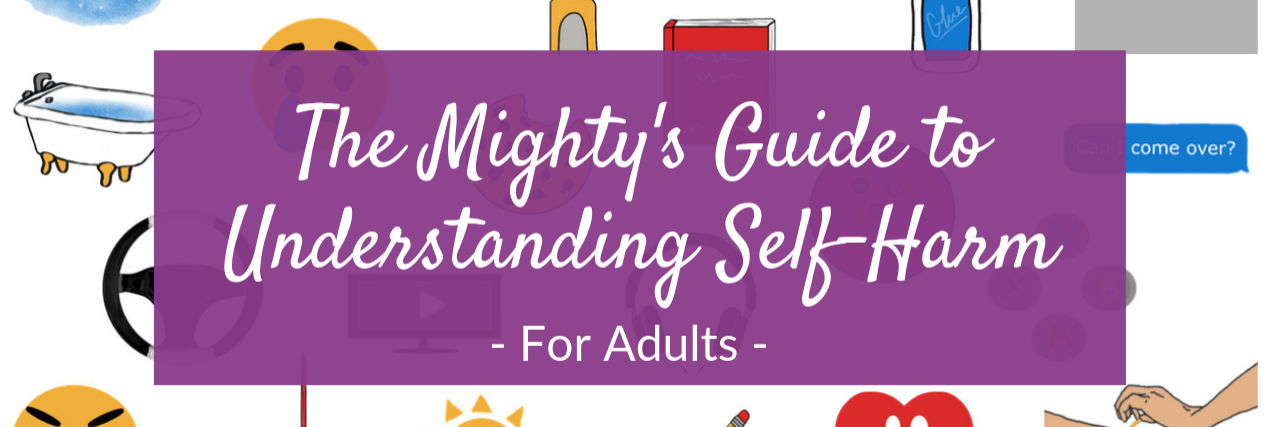For Adults: What to Know if You Self-Harm
Editor's Note
The Mighty’s Condition Guides combine the expertise of both the medical and patient community to help you and your loved ones on your health journeys. For the self-harm recovery guide, we interviewed four mental health experts, read numerous studies and surveyed 2,500 people with a history of self-harm. The guides are living documents and will be updated with new information as it becomes available.
What Is Self-Harm in Adults?
- Though self-harm is most often associated with young people, nearly 6 percent of adults also self-harm
- Adults who self-harm often live with a mental health condition and need support to build health emotion regulation skills
- By learning new coping skills, working with a mental health professional and finding support from loved ones, recovery from self-harm is possible
Learn More About Self-Harm Recovery: Overview | For Young People | For Parents and Loved Ones | Resources

Medically reviewed by Michelle Seliner, MSW, LCSW
How to Talk to Others About Self-Harm | Coping Skills | Recovery From Self-Harm | What to Know About Scars | Do You Need Medical Attention? | How to Get Help In a Crisis
For Adults: What to Know if You Self-Harm
Contrary to popular belief, it’s not just teenagers who self-harm. An estimated 5.5 percent of adults (age 24 or older) self-harm.3 You may have started self-injuring as a young person and haven’t found your footing in recovery yet. Maybe you didn’t start self-harming until you were an adult. You may have self-harmed as a teenager and stopped before starting again in your 40s. There isn’t one picture that describes everyone who self harms. That includes adults of all genders, sexual orientations and races.
While a lot of young people will outgrow self-injury as their brain and they develop tools for emotion regulation, not everyone has a chance to learn those skills. This could be because of trauma you experienced as a child, chaos in your home growing up or an underlying mental health condition. Studies have shown that a significant number of adults who self-harm live with a mental illness that contributes to their self-harm.15
Self-harm can sometimes feel like an addiction, making it hard to stop completely. You also might not have the resources to get treatment from a qualified mental health professional who understands self-injury. There’s also a lot of shame associated with self-harm, especially if you hear incorrect messages that you “should have just outgrown it by now.” Despite these challenges, it is possible to recover from self-harm as an adult, or at any age.

How to Talk to Others About Self-Harm
Self-harm isn’t an easy topic to bring up and you may have a lot of reservations about telling others your history. There are still a lot of myths out there, and it’s hard to know how somebody will react. At some point, you will likely have to talk about self-harm with someone else. This could be your partner, family, friends or your therapist. You may want to share more about yourself and your history. Whatever your reason, reaching out for connection, understanding and support is an important step in your recovery.
How To Talk to Your Loved Ones
When you talk to loved ones about self-harm, you want to feel seen, heard and validated. Given the misconceptions that are still out there, you may be worried about judgment. You don’t want people to think you’re “crazy” or “unstable.” Self-harm is an important part of your history but it doesn’t define you. Talking about it is a difficult and personal conversation to have.
When you’re ready to have the conversation with loved ones or friends, give yourself plenty of time. Try to talk after dinner, for example, not while getting ready for work in the morning. Make sure you’re in a private, comfortable place. Because it’s an emotional conversation for both of you, choosing the privacy of a home is probably a better choice than a public place like the coffee shop. Set yourself up to feel as safe and comfortable as possible.
Think through what you want to say. Rehearse the conversation by writing it out or practicing with your therapist. Anticipate what questions your loved one might ask like, “Why are you still self-harming? I thought that was only something kids do.” “Why didn’t you tell me sooner?” A little preparation ahead of time can help reduce some of the jitters and give you a better chance of saying what you want.
While you always hope for the best outcome, be prepared in case the conversation doesn’t go as planned. Your partner or loved ones might need time to process this new information. They may react with their own emotions. You might feel like they’re asking you to make them feel better, but that’s not your responsibility. If the conversation is hard for you, what can you do to calm back down afterward? Can you spend time with another family member or friend? Have self-care activities at the ready just in case.
What to Expect If You Tell Your Therapist About Self-Harm
If you’re working with a therapist, you’ll probably want to alert them to your history with self-harm. Even 20 years ago, a history of self-harm might lead anxious therapists to hospitalize you. Some therapists — and some states — still might air on the side of caution if they can’t tell the difference between non-suicidal self-injury and a suicide attempt or gesture.
For adults over the age of 18, therapists have a responsibility to maintain confidentiality. Anything you say during a session is privileged and can’t be shared with anyone else without your consent. However, if your therapist believes you are at risk for serious physical harm, suicide or harming others, they must take steps to protect your life. This could include initiating a hospitalization.
If you’re not sure where your therapist stands on self-harm, test the waters before making a disclosure. Ask your therapist how they approach treatment for people who self-injure. Find out what they might do if you disclose self-injury. At its core, self-harm is usually something you do to feel better. A good therapist understands this distinction between self-harm and suicide. An informed therapist also won’t demand you stop right away. They will work with you to reduce your self-injury over time with coping skills and addressing underlying issues.
Self-Harm Resources Online
It’s often hard to find self-injury resources in-person, especially if you’re an adult. While this generally extends to the internet, it’s easier to connect with others who have similar experiences online. There are several websites where you can find recovery stories, chat with others who are also in recovery and find new virtual friends who get it.
You can also find a lot of self-harm information online that isn’t so helpful. Beware of how-to sites or sites that show graphic images of self-harm. These can trigger you. Many negative trolls and cyberbullies hang out in even the safest of spaces, and you don’t need that language in your life. You might also come across sites that suggest you can never recover from self-injury. This simply isn’t true — recovery is possible. The internet and social media are great resources. Just proceed with caution.
How to Self-Harm
If you’re looking up online how to self-harm, see if you can resist the urge using distraction — play with your pet, text your partner, color or draw, go for a drive, watch a movie. If you need immediate support, call the National Suicide Prevention Lifeline at 1-800-273-8255 or reach the Crisis Text Line by texting “START” to 741741.

Coping Skills
When you’ve been self-harming for a long time, it isn’t easy to give up right away. In fact, it’s unfair to expect you can just stop cold turkey. To make the shift from self-harm to recovery, first, it’s helpful to learn new coping skills — alternative activities you can do when you feel the urge to self-harm.7 Likely it won’t be just one or two coping skills you’ll rely on, but a whole list. If you feel the urge to self-harm when you’re angry, it might be more useful to go for a run and burn off the physical energy. But if you’re feeling overwhelmingly sad, a warm bath or curling up on the couch with a soothing book might be a better fit.
Keep in mind you can’t sub in a coping skill for self-harm that will work exactly the same. In the beginning, when you feel the urge to self-injure, alternative coping skills may not seem to work at all. Self-harm works really fast, and when you’ve been doing it for awhile, it can feel intolerable to not get immediate relief when you’re struggling. A coping skill will require you to tolerate uncomfortable feeling states for seconds and minutes longer. That takes some getting used to. It’s helpful to experiment with different coping skills to find what works best for you and when, and get using them over and over.
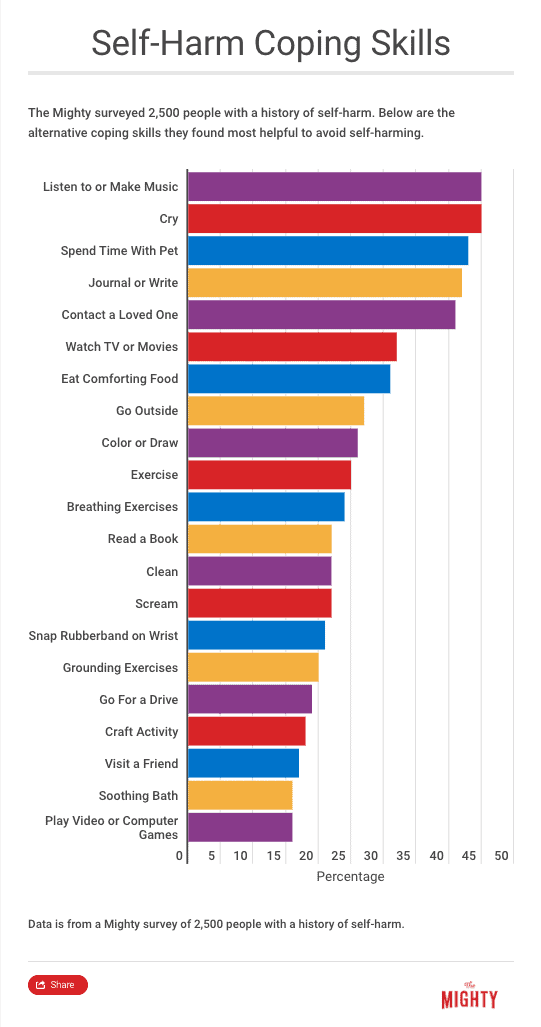
Coping Skills You Can Try
Experiment with different coping and distraction skills to find what works best for you. Whether it’s reading a book, going for a walk, talking to a friend, petting your dog or writing in your journal.5 You might need a different set of coping skills depending on how you feel. When you’re feeling angry, maybe you need to do something active like go for a run. When you’re sad, maybe it’s listening to your favorite song that helps you get through the urge to self-injure.
Here are the coping skills that helped 2,500 people with a history of self-harm most:
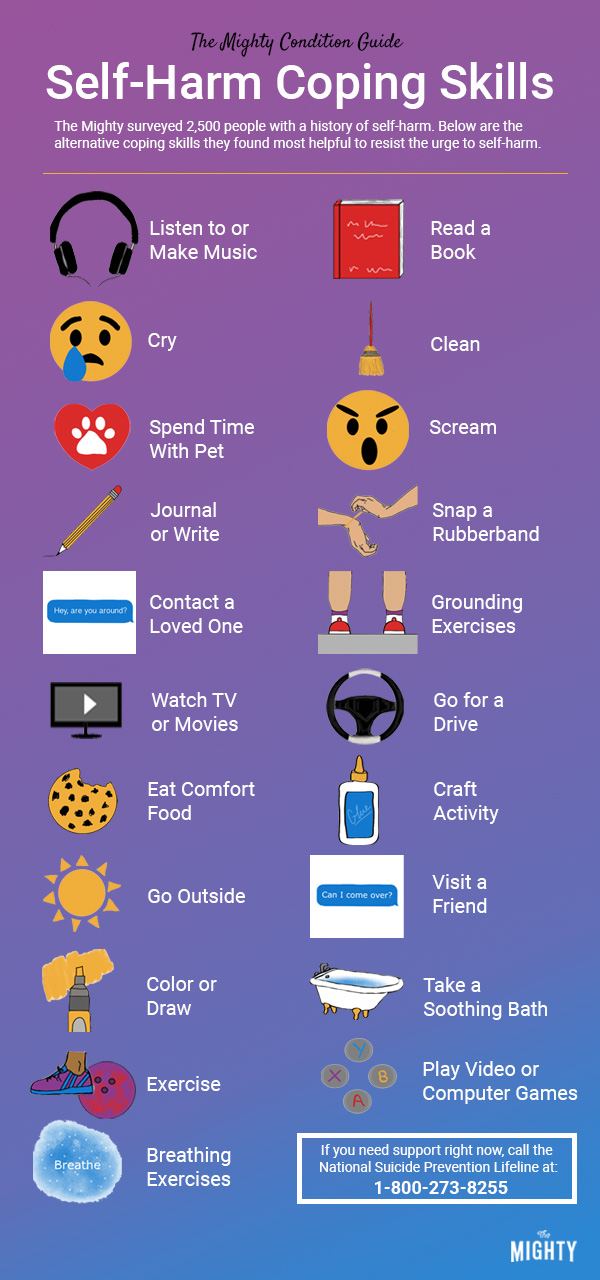
You can also find other ideas here:
- Distraction Techniques and Alternative Coping Strategies (Cornell Research Program on Self-Injury and Recovery)
- A Guide to Coping with Urges (Self-Injury Outreach & Support)
- A Guide to Coping Day-to-Day (Self-Injury Outreach & Support)
- 146 Things to Do Besides Self Harm (Adolescent Self Injury Foundation)
Creating a Safe Environment
You might not be ready to do this right away, but it may help your recovery to make your environment free of self-harm tools.5 This reduces temptation and adds an extra barrier because you’d have to go to greater efforts to self-injure. Remove as many items you might use to self-harm from your living space as possible. Enlist your partner, roommates or friends in this process if that feels helpful. You can also coordinate with your therapist who might be willing to hold onto or collect items to help keep you safe. Set yourself up for success in your home.

Recovery From Self-Harm
Recovery from self-harm is possible, even if you’ve been self-harming for decades. It’s a process that will take time and effort.7 You’ll have good days and weeks and bad days and weeks. Sometimes you’ll be able to effectively use coping skills and alternatives and sometimes you may falter. When you’re working on difficult material in therapy, you might feel more overwhelmed than usual and not know what else to do. This is all a normal part of recovery, so don’t be discouraged.
Self-harm recovery can be conceptualized in two parts. The first part is learning new coping skills, alternatives and distraction techniques when you feel the urge to self-harm. This requires willingly trying new activities instead of self-harm and learning to tolerate longer periods of time when you are struggling. If you stick with it, most people find that over time they get used to coping skills instead of self-harm. However, it won’t happen overnight and it takes practice and repetition.
The other important piece of self-harm recovery is addressing the underlying reasons you self-harm.6 The more you understand the “why” of self-harm, the more likely you are to reduce your feelings of emotional dysregulation overall. As you address the causes of your self-harm, you’ll probably find it gets easier and easier to live life without it. Often this work is best done with a therapist or counselor. You may have an underlying mental illness or trauma that contributes to the self-harm, which can be addressed in therapy. This is also a process that takes time and support.
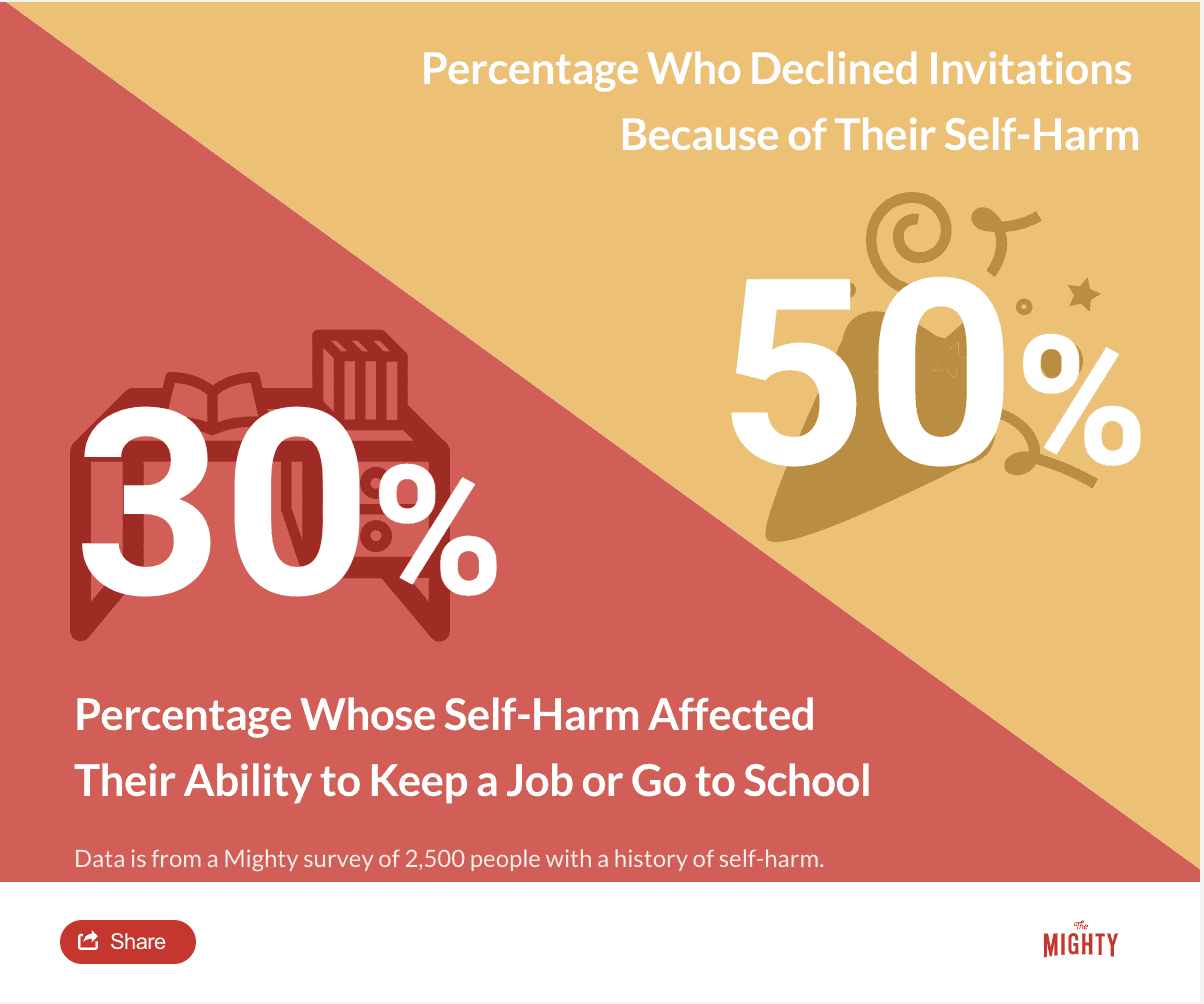
Self-Harm Relapse
Relapse is part of self-harm recovery for a lot of people, especially if you’ve been doing it for a long time.7 A relapse, however, is not a failure. You may have gone without self-injury for six months and then have a relapse. This doesn’t set you back to square one. Celebrate the many months you put into recovery and observe what made that possible. Then analyze what happened to cause the relapse. Gather information you can learn from and incorporate it into your next step. Have realistic expectations for yourself. Recovery takes time and effort.
How to Find a Therapist
When you’re ready to enter self-harm recovery, having a trained therapist on your team can help you address any underlying mental health conditions or traumas while teaching you emotion regulation skills. Therapists also provide a non-judgemental space to talk freely about what you’re experiencing. Unlike loved ones, a therapist is a neutral party who won’t react emotionally to self-harm. You don’t have to protect their feelings — their goal is to help you heal.
When you’re searching for a therapist, know that not all of them understand self-injury.14 Whether you’re searching for providers through your insurance company or on your own, do a little research ahead of time. Investigate and ask questions about their experience and knowledge about working with clients who self-harm. You’ll also want to see how you feel talking to potential therapists. If you don’t feel safe or you’re worried a prospective (or current) therapist isn’t a good fit, keep looking if possible.
If you have health insurance that includes mental health coverage, you might want to look at your company’s directory to find an in-network provider. For those who don’t have insurance, the National Alliance on Mental Illness’ helpline at 1-800-950-NAMI (6264) can help you find a therapist as can web searches for low-cost mental health treatment options and other available supports.8 Some services like BetterHelp and Talkspace offer online or text-based therapy that might be more accessible and affordable for you.
You can also search for local counselors using the search functions on these websites:
Dialectical Behavioral Therapy
One type of therapy that’s known to be highly effective in helping you reduce self-harm is dialectical behavior therapy (DBT).7 One study, for example, found that for every two months of participation in DBT, people were able to reduce their self-harm by 9 percent.9 DBT was originally developed in the 1980s with those who lived with self-harm, suicidal ideation and borderline personality disorder (BPD) in mind. However, DBT has since been shown to be effective for many other mental health conditions, including depression, anxiety, eating disorders and substance use.13
DBT teaches skills that are organized into the following four modules:2, 13
- Mindfulness
- Distress tolerance
- Emotional regulation
- Interpersonal effectiveness
All the DBT skills are designed to help you tolerate big feelings effectively without self-harming, learn how to make decisions that help you balance emotional and rational thinking and help you more effectively interact with others.
You learn valuable skills like:
- Mindfulness, which helps you be in the present moment and focus on one thing at a time
- Radical acceptance, which helps you to tolerate the distress of unpleasant circumstances that you can’t change right away
- How to “ride the wave” of a strong emotion without acting on it
- How to ask for what you want or say no effectively
For young people and families participating in DBT skills groups, you will also learn skills like dialectical thinking, or how to understand and appreciate both perspectives in a given situation. DBT teaches you to approach your thoughts and emotions from a non-judgmental stance, which can be extremely important in learning to reduce self-harm and understanding the non-linear nature of progress.2, 13
A full DBT program includes weekly sessions with an individual therapist, access to a therapist to provide real-time coaching in skills use outside of sessions (usually offered 24/7) and a weekly skills training group with other people experiencing similar things.13 Some therapists will offer treatment that incorporates aspects of the DBT skills described or even a skills training group you can join without participating in a full DBT program (particularly if you already work with another therapist you feel comfortable with).
Cognitive Behavioral Therapy
Another therapy that is sometimes used to decrease self-harm is cognitive behavioral therapy (CBT) because it focuses on changing your thoughts, emotions and behaviors. CBT therapists will help you examine what happens for you in the moment when you feel the need to self-harm and brainstorm strategies to cope with self-harm urges in a more effective way.
Other Types of Therapy
There are hundreds of types of therapy, from talk therapy to DBT and CBT. While DBT and CBT are two of the most recommended types of therapy for reducing self-injury, sometimes it’s hard to find a therapist who uses these skills near you. When you’re looking for a therapist, ask what types of therapy they are trained in, because often therapists know several different kinds of skills or ways of working with people, including DBT or CBT skills. If you can’t find a therapist who knows DBT or CBT skills in your area, look for someone who has experience treating self-harm and who makes you feel comfortable enough to open up.
Group Therapy for Self-Harm
There aren’t many therapy groups specifically for self-injury and they’re hard to find. This is partly because some people believe self-harm is contagious. In other words, if you hear someone else talking about self-harm, you might self-injure even more. If you’re looking for group therapy, consider a DBT skills group, which will help you learn effective, new skills for reducing self-harm.
Medication
Medication might be a necessary part of your recovery from self-harm, especially if part of the underlying cause is a mental health condition. Generally, a psychiatrist will prescribe your medication, though family doctors can as well. Psychiatrists are medical doctors who specialize in mental health, so they usually have the best handle on the medications that could best fit your situation. Taking medication can help level out your mood and give you a leg up in recovery. It won’t fix everything. It can help clear enough mental space and energy so it’s easier to use coping skills and work through other issues in therapy.
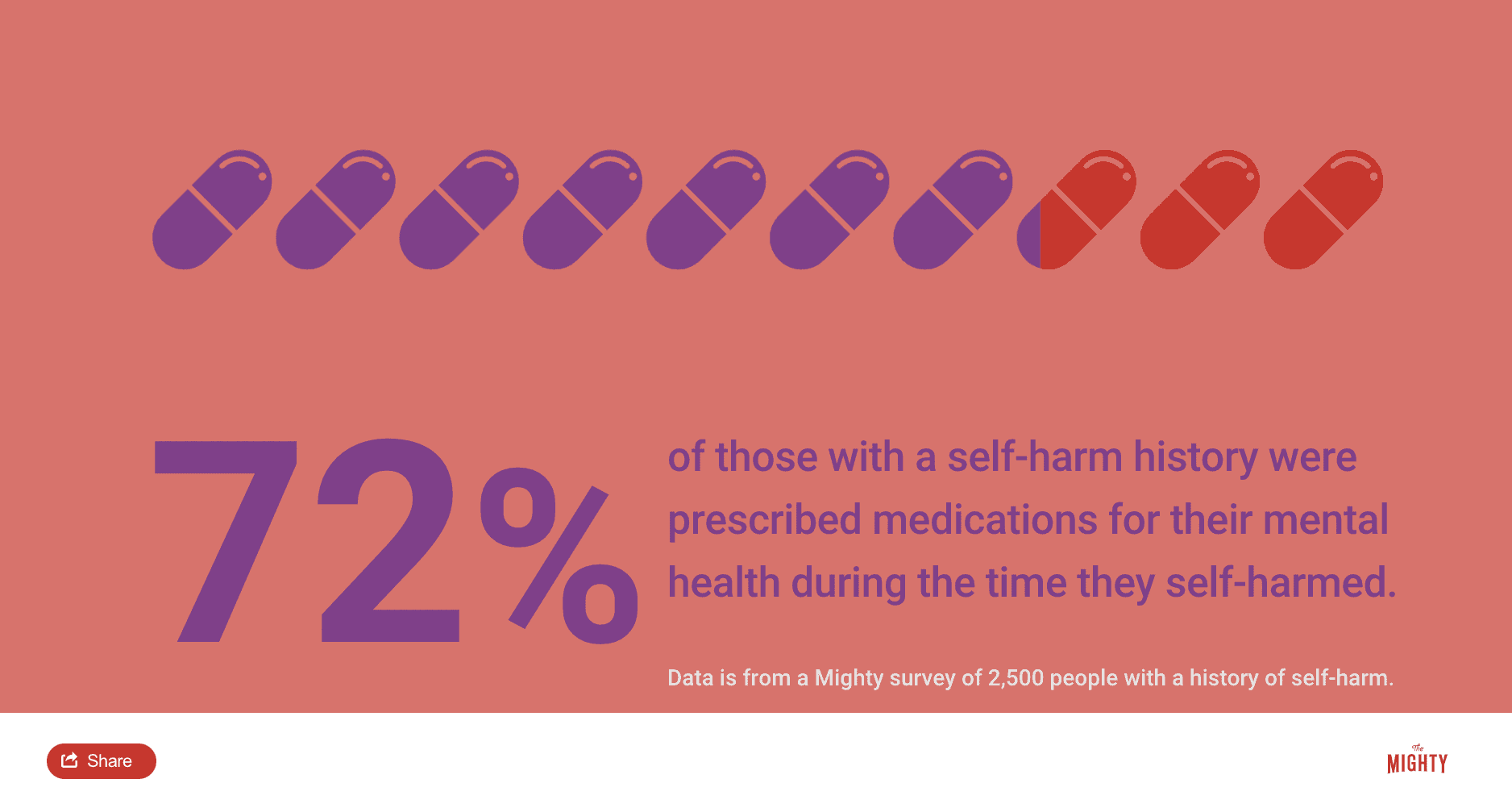

What to Know About Scars
Scarring is one of the permanent effects of self-harm for most people. Everybody views their scars differently. They could be a painful reminder of your past and all the difficult feelings associated with it. Maybe you’d rather not have to look at them and don’t want anybody to see them. On the other hand, you might view your scars as a sign of strength. They’re symbols of what you’ve overcome and the resilience it took to get where you are now. Either way, learning self-acceptance for your scars is also part of the recovery process.7
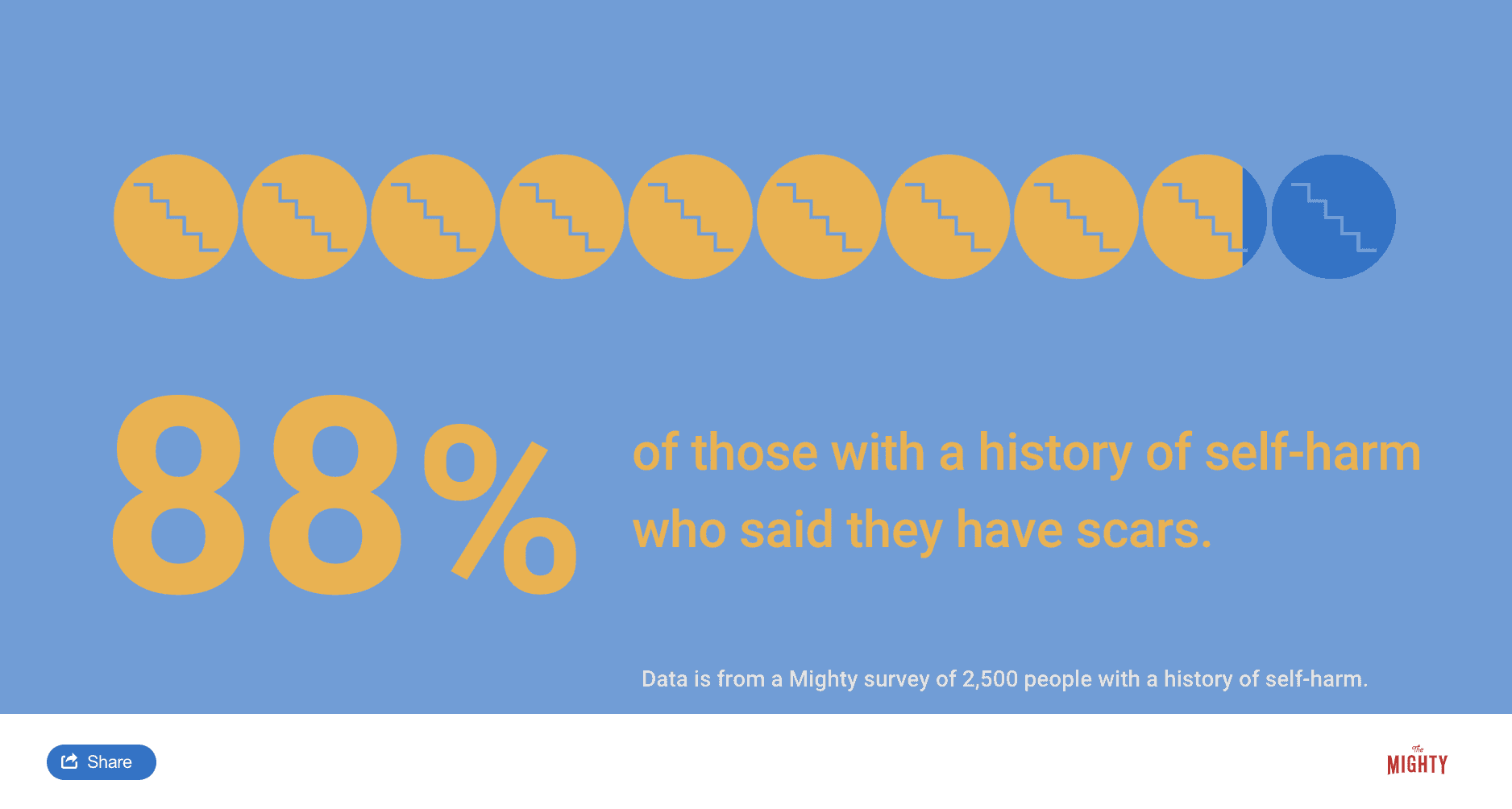
Answering Questions
People can be curious, especially young people, so at some point, you’ll probably be asked about your scars by someone you don’t know that well. When people ask about your scars, they don’t necessarily realize the position they put you in, or what they’re really asking. Self-harm isn’t simple, especially because it’s usually tied to an emotional and difficult history. Even if you prefer to keep your scars hidden most of the time, it can be helpful to plan ahead and have some responses ready in case people ask about your scars.
When a child asks questions, they’re likely just curious. In this case, you can respond by explaining they’re scars and turn the question back to them by asking, “Do you have any scars?” Adults are a different story. They may also be curious, but they’re not always as easy to brush off. Some people who self-injure might opt to dodge the question with a story like, “They’re from an old accident.” It can also be effective to politely but firmly close the conversation. Try responses like, “Thanks for asking, but that’s not a story I am willing to share right now.” Or, “I appreciate the concern. My scars represent a hard time from my past and this isn’t the place for a conversation about it.”10
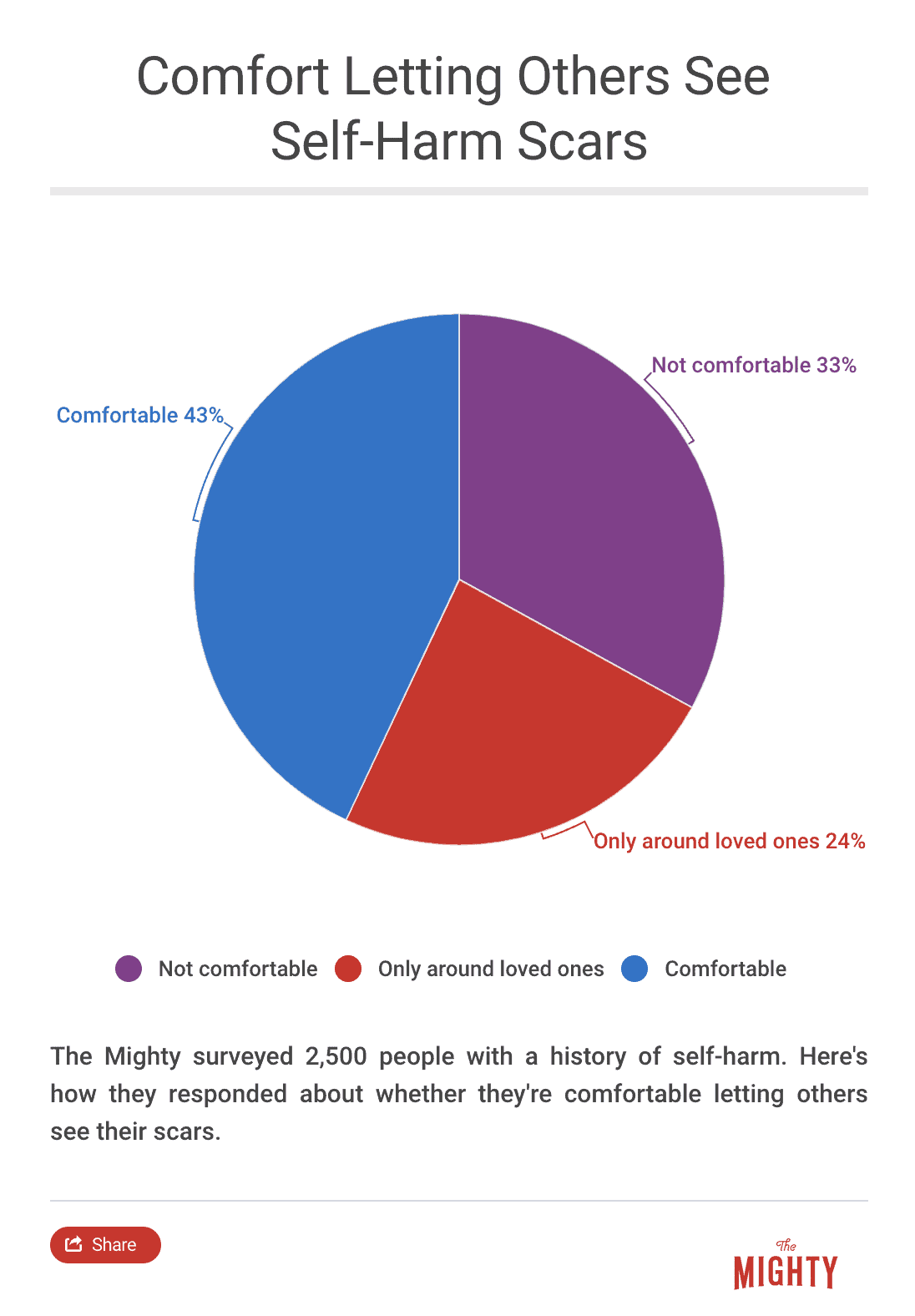
Tattoos
Tattoos have become a powerful symbol of self-harm recovery for many people. They can be a visual reminder of all you’ve been through and survived.12 They can also serve as a creative way to cover self-harm scars.11 Whether it’s a beautiful piece of art or a meaningful phrase, tattoos let you take hold of your own story. If you’re interested in a tattoo, be sure to find a reputable shop to avoid infections or other complications. You may want to check with your tattoo artist ahead of time to learn how much healing time old scars will need before they can be tattooed over. A skilled tattoo artist can also help you design a piece you’ll love that fits on your body with your scars.
Looking for self-harm tattoos? Check out some of these articles others have found helpful:
- 28 Tattoos That Give Us Hope for Self-Harm Recovery
- 28 Tattoos That Cover Self-Harm Scars
- How Tattoos Are Helping Me Recover From Self-Harm
- What Getting Tattoos Means to Someone With a History of Self-Harm
Scar Treatments
Some of your scars may not be deep or noticeable, and some fade over time. Some people look into scar treatments for their bigger scars or scars in visible areas. To learn about your scar treatment options, consult a doctor. A dermatologist, in particular, would be well-equipped to advise you on what options could be available to you. It may also be possible to reduce your scarring by taking care of your wounds as they heal.1

Do You Need Medical Attention?
Properly care for self-harm wounds is essential to your well-being, even if the wound is minor. If your wounds are serious, it’s important to get additional medical help to avoid infection and further health complications. You may have a lot of feelings about this. Medical doctors and emergency room staff don’t always have a good understanding of self-harm. You may have been sent to a psychiatric hospital one too many times in the past when you’ve sought medical treatment.
These are understandable concerns, and studies show you’re not alone if you resist getting wounds checked out. Among college students, one study showed that of the third of them who had wounds serious enough to need medical attention, only 5 percent actually went to the doctor or emergency room.4 Improper care of your wounds may also be a part of your self-harm ritual. However, as you work toward recovery, taking care of them is essential.
Plan ahead and get informed about your treatment options in advance. You could even get certified in first aid so you know the proper treatment for minor wounds. Then take it a step further to create an emergency plan. Consult with your therapist or psychiatrist about medical doctors in your area who understand self-harm. Call doctors ahead of time. Ask what they know about self-harm and how they would handle a self-inflicted wound. By having a safe doctor you can go to in an emergency, you’ll reduce your stress level and increase the likelihood of getting the medical care you need.

How to Get Help In a Crisis
Self-harm on its own isn’t usually a suicide attempt. However, if you self-harm, you’re at higher risk for suicidal thoughts or attempts. If you find yourself feeling so overwhelmed and hopeless that you don’t want to live anymore or you’re making plans to die, reach out for help immediately. You are valuable and important. You’re not alone. Call a loved one or your therapist or reach out to a crisis hotline:
If you are feeling suicidal, there is hope.
- You can call the National Suicide Prevention Lifeline 24/7 at 1-800-273-8255
- You can reach the Crisis Text Line 24/7 by texting “START” to 741-741
- You can call The Trevor Project, an LGBT crisis intervention and suicide prevention hotline, 24/7 at 1-866-488-7386
If you are hard of hearing, you can chat with a Lifeline counselor 24/7 by clicking the Chat button on this page, or you can contact the Lifeline via TTY by dialing 800-799-4889.
To speak to a crisis counselor in Spanish, call 1-888-628-9454.
Head here for a list of crisis centers around the world.
For additional resources, see the American Foundation for Suicide Prevention and SAVE (Suicide Awareness Voices of Education).
You can read the following stories from people who’ve been there:
- If You Feel Like You’re ‘Losing’ to Your Mental Illness, This Is Your Reason to Stay
- For When Your Only Thought Is Suicide
- The Difference Between Wanting to Die and Wanting the Pain to Stop
- Dear Suicidal You
And for additional messages of hope, click here.
You are not alone.
Learn More About Self-Harm Recovery: Overview | For Young People | For Parents and Loved Ones | Resources

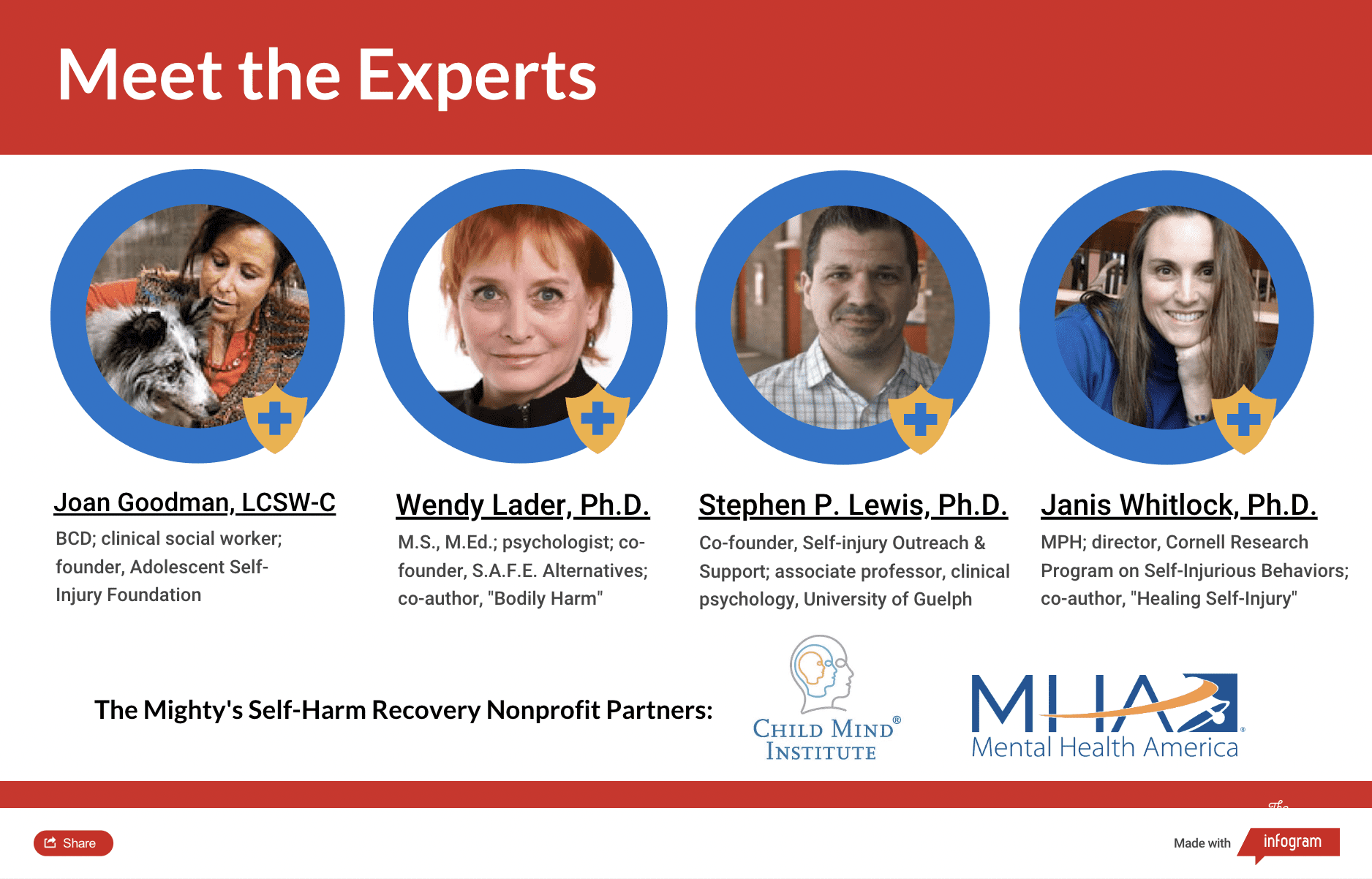
Sources
- American Academy of Dermatology. (n.d.). Scars: Overview. Retrieved from https://www.aad.org/public/diseases/bumps-and-growths/scars
- Behavioral Tech. (n.d.). What is Dialectical Behavior Therapy (DBT)? Retrieved from https://behavioraltech.org/resources/faqs/dialectical-behavior-therapy-dbt/
- Cornell Research Program on Self-Injury and Recovery. (n.d.). Self-Injury. Retrieved from http://www.selfinjury.bctr.cornell.edu/perch/resources/siinfo-2.pdf
- DeAngelis, T. (2015, July/August). Who self-injures? Retrieved from https://www.apa.org/monitor/2015/07-08/who-self-injures.aspx
- Goodman, J. (2018). Self-injury [Telephone interview].
- Lader, W. (2018). Self-injury [Telephone interview].
- Lewis, S. (2018). Self-injury [Telephone interview].
- National Alliance on Mental Illness. (n.d.). NAMI Helpline. Retrieved from https://www.nami.org/Find-Support/NAMI-HelpLine
- Priebe, S., Bhatti, N., Barnicot, K., Bremner, S., Gaglia, A., Katsakou, C., . . . Zinkler, M. (2012). Effectiveness and Cost-Effectiveness of Dialectical Behaviour Therapy for Self-Harming Patients with Personality Disorder: A Pragmatic Randomised Controlled Trial. Psychotherapy and Psychosomatics,81, 356-365. doi:https://doi.org/10.1159/000338897
- Rothenberg, P., & Whitlock, J. (2013). Wounds heal, but scars remain: Responding when someone notices and asks about your past self-injury. Retrieved from http://www.selfinjury.bctr.cornell.edu/perch/resources/wounds-heal-pm-2.pdf
- Schuster, S. (2016, December 13). 28 Tattoos That Cover Self-Harm Scars. Retrieved from https://themighty.com/2016/12/tattoos-that-cover-self-harm-scars/
- Schuster, S. (2018, March 16). 28 Tattoos That Give Us Hope for Self-Harm Recovery. Retrieved from https://themighty.com/2018/03/self-harm-recovery-tattoos/
- Stern, J. (2019). Self-injury [Written communication].
- Sweet, M., & Whitlock, J. (2010). Therapy: What to expect. Retrieved from http://www.selfinjury.bctr.cornell.edu/perch/resources/therapy-what-to-expect-pm-2.pdf
- Whitlock, J. (2018). Self-injury [Telephone interview].

